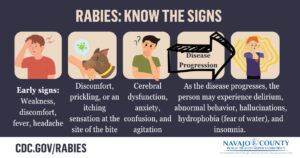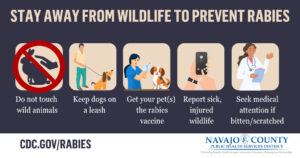NAVAJO COUNTY- Foxes attacked several people in Show Low and Pinetop/Lakeside-Test positive for rabies.
The Navajo County Public Health Services District (NCPHSD) is alerting the public of rabid animals across the region. Since January 18th there have been four instances of wild foxes approaching and attacking humans in the Show Low, Pinetop/Lakeside area. Navajo County Animal Care and Control was able to trap two infected animals and send their remains to the state lab for testing. The lab did confirm that the remains were positive for rabies.
Navajo County Animal Care is continuing an active search for any remaining infection.
“In Tucson a skunk, a fox and two bobcats have bitten or scratched people in four separate incidents of suspected rabies since Nov. 27,” said Arizona Game and Fish Department spokesman Mark Hart.
Rabies is a preventable viral disease most often transmitted through the bite of a rabid animal. Most of the rabies cases that are reported each year occur in wild animals such as bats, raccoons, skunks, and foxes, although any mammal can get rabies.
NCPHSD stresses that a bite from a rabid animal can be potentially fatal if not treated in a timely manner. The public should take precautions to avoid contact with wildlife as well as stray domesticated animals such as cats or dogs throughout the region.
NCPHSD also reminds the public to make sure that rabies vaccinations are up-to-date for pets and any valuable livestock or horses for whom a rabies vaccine is available. If a pet is exposed to a high-risk wild animal such as a bat, skunk, raccoon, fox or coyote contact a veterinarian immediately.
Rabies is a virus that affects the nervous system (brain and nerves). People can get rabies after being bitten by an infected animal. Rabies can also be contracted when saliva or spit from a rabid animal gets directly into a person’s eyes, nose, mouth, or an open wound. If you have been bitten by any animal or had contact with the saliva of a wild animal, seek immediate medical attention. Rabies treatment, if needed, must begin quickly.
The signs and symptoms of a rabies infection in humans include those that are similar to the flu, such as weakness, discomfort, fever, or headache. There also may be discomfort, prickling, or an itching sensation at the site of the bite. These symptoms may last for days. Symptoms then progress to cerebral (brain) dysfunction, anxiety, confusion, and agitation. As the disease progresses, the person may experience delirium, abnormal behavior, hallucinations, hydrophobia (fear of water), and insomnia. This period of disease usually lasts two to ten days. Once clinical signs of rabies appear, the disease is nearly always fatal.
The signs and symptoms of rabies in animals can vary. Symptoms in animals are often similar to those in humans. An animal does not have to be aggressive or exhibit other symptoms to have rabies. Changes in any animal’s normal behavior can be early signs of rabies. For instance, a bat that is active during the day, found on the ground, or is unable to fly may be rabid.


According to Navajo County Emergency Services, The following tips can help prevent the spread of rabies:
- Do not have physical contact with stray or wild animals.
- Never bring stray or wild animals into your home. Do not try to nurse sick wild animals back to health. Call animal control for assistance.
- Do not feed or unintentionally attract stray or wild animals with open garbage cans or litter.
- Ensure that your pets are up to date on their rabies vaccine.
- Keep pets on a leash while recreating in the outdoors.
- Teach children to never handle unfamiliar animals, wild or domestic, even if they appear friendly.
- Maintain homes and other building to prevent unwanted animals from getting inside.
- A bite from a bat is difficult to detect; therefore, if you find a bat in your home, do not release the bat back to the outdoors until speaking with animal control or public health officials as the bat may need to be captured for rabies testing to determine if you need rabies treatment.
To report a bite from a wild animal or an animal acting suspicious, contact the Navajo County Sheriff’s Office dispatch at (928)-524-4050.
For more information please visit:
Mountain Daily Star Staff Reports-Navajo County Emergency Management

